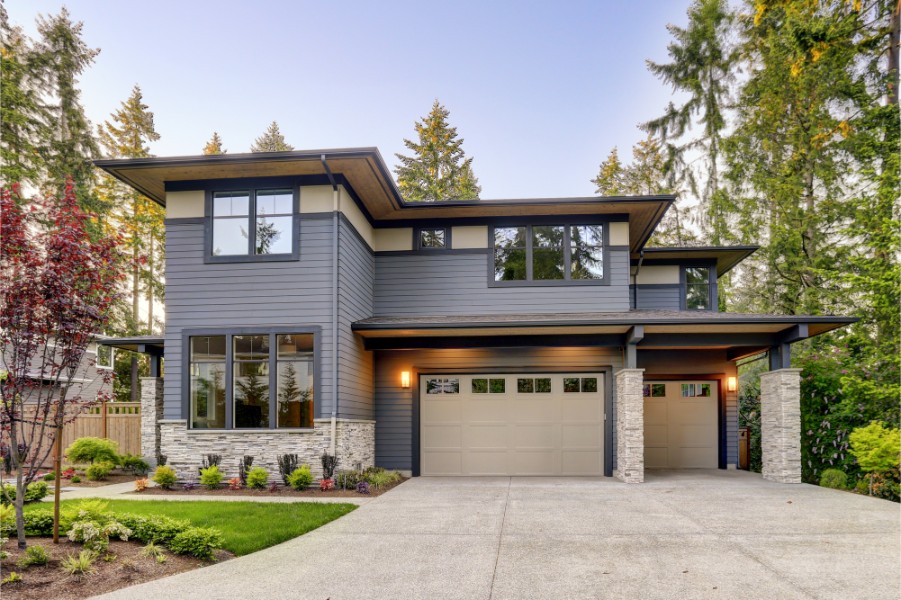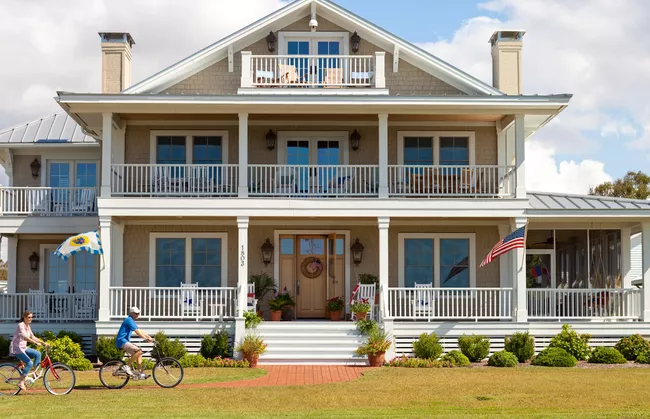:max_bytes(150000):strip_icc():gifv():format(webp)/gray-exterior-white-trim-path-09767f9e-83bad323e9d2473b90e69add9165c12f.jpg) Your home’s exterior color scheme plays a pivotal role in its overall look and feel. The combination of paint colors on your siding, trim, front door, and other exterior elements sets the tone before you even step foot inside. Learn with Pritish Kumar, how to decide which exterior colors go together and how to pick hues that work for your home’s style and architecture.
Your home’s exterior color scheme plays a pivotal role in its overall look and feel. The combination of paint colors on your siding, trim, front door, and other exterior elements sets the tone before you even step foot inside. Learn with Pritish Kumar, how to decide which exterior colors go together and how to pick hues that work for your home’s style and architecture.
:max_bytes(150000):strip_icc():format(webp)/light-blue-house-stone-walkway-a6bb84d2-f6647bb5ae034281b08d7fa3155d9154.jpg) Blue Exterior Color Scheme
Blue Exterior Color Scheme
Neutrals like white don’t have to be one-note. Pick a shade of white with undertones that match the rest of your exterior color scheme. On this home, white siding with blue undertones melds gracefully with a bright blue front door and powder-blue porch furniture and pendant light. Each color in the trio is distinct, but their commonalities create perfect harmony.
:max_bytes(150000):strip_icc():format(webp)/tan-home-exterior-vinyl-siding-991a55ca-2e59fe557c584f37a23ee41880e3385f.jpg)
Neutral Exterior Paint Colors
You can add interest to an exterior color scheme without using brightly colored paint colors. An all-neutral palette looks particularly polished when accented with hits of black. To give your beige exterior a more sophisticated feel, try painting the shutters and front door black. Use white on the trim and other exterior elements so the look is crisp and clean instead of one-note.

Gray Exterior Color Scheme
Because it typically covers the most surface area on a home, siding will often provide the foundation color for your exterior scheme. Consider the undertones of your siding color, and choose two or three other shades that complement the hue. The gray siding on this home, for example, has strong blue undertones, which are highlighted by the turquoise front door and patio furniture. White trim stands out brightly against the cool exterior colors.
:max_bytes(150000):strip_icc():format(webp)/house-exterior-gray-light-green-102787980-43e9b10b96fe432491914f86abe4858d.jpg)
Monochromatic Exterior Color Scheme
The danger of choosing a single hue for an exterior color scheme is that, without careful planning, it can feel boring and dated. To avoid that, try this exterior paint color idea: Identify an accent piece on your home (window frames, shutters, trim, or the front door for example) and paint it either a darker or a lighter shade of your main color. To add more contrast, consider choosing one complementary color, such as red, for an unexpected highlight.
:max_bytes(150000):strip_icc():format(webp)/gray-house-bright-red-door-5117ba78-2930f3d4eac840ac983ad184abf79252.jpg)
Standout Exterior Colors
It’s OK to pick just one element that stands out in your exterior color scheme; more often than not, that’s the front door. The reason is aesthetic as well as practical: A bright front door hue such as this red signals visitors where to enter. On this house, the bulk of the color (warm gray) helps the low-slung profile gently recede into the landscape.
:max_bytes(150000):strip_icc():format(webp)/colonial-style-home-blue-door-purple-shutters-d6b85f63-81e3b5a298b84990a8fa23204f900d5c.jpg)
Exterior Accent Colors
Some of the best exterior house paint ideas are those that turn tradition on its head. Take, for example, Colonial-style homes, which are often painted in a single color, many times white. While a white exterior color scheme has classic appeal, there are ways to update and modernize that choice, too. For example, the accent shades chosen here—a dusty lavender-gray and a bright turquoise—would normally not be used in the same color scheme. Here, though, the grayish-purple offers a refined accent on the shutters, while the turquoise—a brighter spin-off of some of those same blue-purple tones—directs foot traffic to the front door. Plus, if you’re looking for easy exterior paint ideas, adding color to just your shutters and front door is the way to go.
:max_bytes(150000):strip_icc():format(webp)/green-gray-house-light-accents-red-door-a40dea09-9d6f87adaf734e12999e83d6138c973a.jpg)
Elegant Exterior Color Scheme
Judicious use of an accent color can lend your home a more refined exterior scheme. It’s a choice that works well with classic home styles, particularly because it doesn’t overpower their traditional forms. This home, which deftly matches a deep green-gray with a lighter tone, also relies on an orange-red hue found in the copper roof accents and repeated on the wood front door. That tone carries over onto rooflines and side doors to provide a continuing color line for the eye to follow.

Choosing House Paint Colors
Selecting from a nearly endless parade of exterior paint color ideas can be overwhelming, and the very act of exterior home painting is a big job. Follow these tips for choosing exterior paint colors that go together so you can be confident as you undertake your painting project. With a little know-how, you can create a color scheme that suits your home’s architecture and style and reflects your tastes.
Materials for Exterior Color
Many people equate contemporary homes with a limited exterior color palette. But modern-style homes offer inspiration for a diverse way to showcase color and pattern, even if the palette is fairly neutral. If you’re building new or remodeling your exterior, consider all the shapes and sizes of brick as a way to create an accent feature, rather than relying solely on paint for adding color. Here, the pattern on the brick section of the front façade is nearly mosaic-like. Functional features, such as drain pipes or front steps, can be a wonderful way to include different colors or materials, too.
:max_bytes(150000):strip_icc():format(webp)/blue-house-primary-color-accents-yellow-door-c68a6314-289631344bdb4ab2b97f7e040473b19b.jpg)
Primary Color Scheme
The primary colors—red, yellow, and blue—are the basis of all other hues, and as such, they’re naturally complementary. But very few of us would consider painting a home in red, yellow, and blue, as represented in the original color wheel. However, when given rich depth or startling brightness, the hues provide an exterior color scheme that’s at once distinctive and deeply satisfying. The key to color combinations is to select one color that pops (here, yellow) and another that’s used sparingly (in this case, red). The rich shade of blue acts almost as a neutral for the exterior house paint color.
:max_bytes(150000):strip_icc():format(webp)/green-beige-craftsman-house-exterior-8325a4cf-ef97b55db34144518156a687c775cabc.jpg)
Green Exterior Color Scheme
Complement beige exterior trim and natural stonework with warm shades of green. Hunter-green shutters and shake shingles stand out against this home’s soft sage-green siding. Green garage doors continue the nature-inspired color palette, while copper light fixtures pick up the amber hues of the surrounding stone.
:max_bytes(150000):strip_icc():format(webp)/classic-home-shake-shingles-white-accents-8f5a92d3-d4b105b5532e483a97c5ced7af047a8e.jpg)
Exterior Stain Colors
As with traditional painted colors, stain offers a wide range of tones and shades to choose from, each of which can revive your home’s exterior. Wood stains in midrange hues, in particular, work well on a variety of home styles. As with exterior wood paint colors, it’s best to sample the stain on a swath of exterior wall to see how the color looks and feels throughout the day. For a fool-proof accent color, look to white. For more classically styled homes, white is a traditional accent for window trim, pillars, and doors.
:max_bytes(150000):strip_icc():format(webp)/exterior-harris-house-7cZV3XkkaHTACqrzGhkJf6-05f7c76d19224765abaa470ba4e8a000.jpg)
Classic Exterior Paint Colors
When it comes to exterior color schemes, there’s something to be said for tried-and-true combinations. This classic abode might look out of place with any palette other than warm beige for the siding and bright white around windows and on rails. Look to exterior light fixtures for adding complementary materials or colors. On this exterior, the dark bronze lantern-style sconces balance the home’s symmetry, with a pair flanking the doors on all three floors.
:max_bytes(150000):strip_icc():format(webp)/seafoam-green-house-white-accents-a6f4a3ca-29cff01af8f14d65b17f94964fa0d173.jpg)
Contrasting Exterior Color Scheme
If your home is surrounded by a natural landscape, you can take one of two approaches to exterior paint color ideas. First, you can pick hues that will make the home recede into the background of trees and plants. Or you can choose a standout color that calls attention to the style of your space. This home does the latter; its seafoam green exterior wood paint selection stands in contrast to the lush green backdrop of the tree canopy. When it comes to pastel shades, white is a successful accent color that adds contrast without being too jarring.

Exterior Color Dos and Don’ts
Selecting an exterior color scheme is a big decision. The level of commitment is more intense than picking a wall color. (Don’t like your wall color? Repaint it in a weekend. Don’t like your siding color? That’s one you might have to live with.) But knowing a few exterior color dos and don’ts will save you a lot of color regret. See how to play up your home’s best features and pick the right hues with these simple exterior color rules.
:max_bytes(150000):strip_icc():format(webp)/white-stucco-house-white-shutters-stone-accents-c4e84193-c7abb6dffa974b25bc6d1132baa8216c.jpg)
Natural Exterior Colors
For a façade with texture, a tone-on-tone color palette makes the case for simplicity. White stucco and white shutters create a clean look, while a section of stone above the front stoop draws the eye to the front door. The tones of the roof shingles play off the stone colors for a cohesive yet simple exterior.
:max_bytes(150000):strip_icc():format(webp)/small-monochromatic-home-brick-siding-weathered-wood-cd1a74f7-140b6341efa64cd5af2ecad154710c60.jpg)
Neutral Exterior Color Scheme
While a multicolor palette is certainly eye-catching, a single-hue exterior can also cause passersby to stop and take notice. This small home commands a presence, thanks to its charcoal gray brick siding and similar-tone metal roof. Plenty of lush greenery and a handsome weathered wood door ensure the exterior is stylish, not foreboding.
:max_bytes(150000):strip_icc():format(webp)/contemporary-gray-home-dark-wood-accents-3ade2c7c-4695db2424224d1190a25e7a065f5ef8.jpg)
Exterior Color Schemes with Wood
By itself, steely gray can be a sterile choice for exterior house color combinations. But if this cool-minded hue tops your preferred color list, consider warming it up. That can be done in a number of ways, such as a bright accent color like orange that’s on the warm end of the color scheme. A contrasting material, such as wood, can also be a good choice, particularly when stained a medium to dark color. In this contemporary scheme, a rich gray provides a good bridge between the two hues.
Reference
https://www.bhg.com/home-improvement/exteriors/curb-appeal/best-exterior-house-color-schemes/


:max_bytes(150000):strip_icc():format(webp)/gray-contemporary-home-brick-wood-accents-b2366d04-5799cb8c47014c2e86ab7ee7362a792a.jpg)









